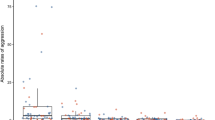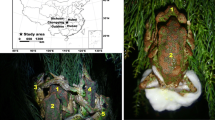Abstract
Behavioral interactions between individuals of the same sex can affect the outcome of intersexual selection. For this reason, intrasexual selection is oftentimes examined independently from intersexual selection in studies aimed at understanding mating behaviors. However, a more complete understanding of sexual selection effects within a population can only come from exploring both intrasexual and intersexual selection and the potential interactions between the levels of selection. Association preferences in male and female Etheostoma fonticola do not reveal a size preference for same sex or opposite-sex individuals. However, male-male interactions may influence female choice in E. fonticola. We examined whether male E. fonticola that differ in body size exhibit differences in agonistic behaviors and mating success. Larger males do exhibit higher rates of aggressive behaviors and smaller males, in turn, exhibit more defensive behaviors. However, differences between larger and smaller males in male-male interactions did not translate into differences in spawning success. These results suggest that male size influences dominance relationships in E. fonticola but not mating success. There were also no differences between large and small males in mating attempts, which could be an outcome of the year-round breeding season found in this species, females laying eggs singly, or males fertilizing eggs individually.



Similar content being viewed by others
References
Andersson M (1994) Sexual selection. Princeton University Press, Princeton
Aspbury AS, Basolo AL (2002) Repeatable female preferences, mating order and mating success in the poeciliid fish, Heterandria formosa. Behav Ecol Sociobiol 51:238–244
Basolo AL (2004) Variation between and within the sexes in body size preferences. Anim Behav 68:75–82
Brooks R, Endler JA (2001) Female guppies agree to differ: phenotypic and genetic variation in mate-choice behavior and the consequences for sexual selection. Evolution 55:1644–1655
Cummings M, Mollaghan D (2006) Repeatability and consistency of female preference behaviour in a northern swordtail, Xiphophorous nigrensis. Anim Behav 72:217–224
Eberhard WG (1996) Female control: sexual selection by cryptic female choice. Princeton University Press, Princeton
Farr JA (1989) Sexual selection and secondary sexual differentiation in poeciliids: determinants of male mating success and the evolution of female choice. In: Meffe GK, Snelson FF Jr (eds) Ecology and evolution of livebearing fishes (Poeciliidae). Prentice Hall, New Jersey, pp 91–124
Fuller RC (2003) Disentangling female mate choice and male competition in the rainbow darter, Etheostoma caeruleum. Copeia 2003:138–148
Gabor C (1999) Association patterns of sailfin mollies (Poecilia latipinna): alternative hypotheses. Behav Ecol Sociobiol 46:333–340
Grant JWA, Colgan PW (1983) Reproductive success and mate choice in the johnny darter Etheostoma nigrum (Pisces: Percidae). Can J Zool 61:437–446
Gumm JM, Feller KD, Mendelson TC (2011) Spectral characteristics of male nuptial coloration in darters (Etheostoma). Copeia 2011:319–326
Henson SA, Warner RR (1997) Male and female alternative reproductive behaviors in fishes: a new approach using intersexual dynamics. Annu Rev Ecol Syst 28:571–592
Hubbs C, Schlupp I (2008) Juvenile survival in a unisexual/sexual complex of mollies. Env Biol Fish 83:327–330
Hunt J, Breuker CJ, Sadowski JA, Moore AJ (2009) Male-male competition, female mate choice and their interaction: determining total sexual selection. J Evolution Biol 22:13–26
Jeswiet SB, Lee-Jenkins SSY, Ramnarine IW, Godin JJ (2011) Sperm competition risk and mate choice in male Trinidadian guppies, Poecilia reticulata. Anim Behav 81:639–644
Knapp RA, Sargent RC (1989) Egg-mimicry as a mating strategy in the fantail darter, Etheostoma flabellare: females prefer males with eggs. Behav Ecol Sociobiol 25:321–326
Lehtonen TK, Lindstrom K (2008) Repeatability of mating preferences in the sand goby. Anim Behav 75:55–61
Linam GW, Mayes KB, Saunders KS (1993) Habitat utilization and population size estimate of fountain darters, Etheostoma fonticola, in the Comal River, Texas. Tex J Sci 45:341–348
Martin MD, Mendelson TC (2013) Incomplete behavioral isolation and asymmetric female preference in darter sister species (Percidae: Etheostoma). J Fish Biol 83:1371–1380
Maynard Smith J, Brown RLW (1986) Competition and body size. Theor Popul Biol 30:166–179
Maynard Smith J, Parker GA (1976) The logic of asymmetric contests. Anim Behav 24:159–175
McPeek MA (1992) Mechanisms of sexual selection operating on body size in the mosquitofish (Gambusia holbrooki). Behav Ecol 3:1–11
Mendelson TC, Imhoff VE, Venditti JJ (2007) The accumulation of reproductive barriers during speciation: postmating barriers in two behaviorally isolated species of darters (Percidae: Etheostoma). Evolution 61:2596–2606
O’Rourke CFO, Mendelson TC (2014) The fitness consequences of plastic responses to adult sex ratio in a paternal care fish. Anim Behav 87:77–83
Phillips CT, Alexander ML, Gonzales AM (2011) Use of macrophytes for egg deposition by the endangered fountain darter. Trans Am Fish Soc 140:1392–1397
Porter BA, Fjumera AC, Avise JC (2002) Egg mimicry and allopaternal care: two mate-attracting tactics by which nesting striped darter (Etheostoma virgatum) males enhance reproductive success. Behav Ecol Sociobiol 51:350–359
Pyron M (1995) Mating patterns and a test for female mate choice in Etheostoma spectabile (Pisces, Percidae). Behav Ecol Sociobiol 36:407–412
Rowland WJ (1989) The ethological basis of mate choice in male threespine sticklebacks, Gasterosteus aculeatus. Anim Behav 38:112–120
Ryan MJ, Keddy-Hector A (1992) Directional patterns of female mate choice and the role of sensory biases. Am Nat 139:S4–S35
Schenck JR, Whiteside BG (1976) Distribution, habitat preference and population size estimate of Ethoestoma fonticola. Copeia 1976:697–703
Schenck JR, Whiteside BG (1977) Reproduction, fecundity, sexual dimorphism, and sex ratio of Etheostoma fonticola (Osteichthyes: Percidae). Am Midl Nat 98:365–375
Stiver KA, Alonzo SH (2010) Large males have a mating advantage in a species of darter with smaller, allopaternal males Etheostoma olmstedi. Curr Zool 56:1–5
Strange RM (2001) Female preference and the maintenance of male fin ornamentation in three egg-mimic darters (Pisces: Percidae). J Freshwater Ecol 16:267–271
Winn HE (1958) Comparative reproductive behavior and ecology of fourteen species of darters (Pisces-Percidae). Ecol Monogr 28:155–191
Acknowledgments
We thank the US Fish and Wildlife Service (USFWS)’s San Marcos Aquatic Resources Center staff for use of facilities and support. We also thank the members of the GASP Lab, for their insight and suggestions. Additionally, we thank M. Martin and J. Gumm for helpful advice on experimental design. Finally, thanks are given to three anonymous reviewers for helpful comments and suggestions. This information is distributed solely for the purpose of pre-dissemination peer review under applicable information quality guidelines. It has not been disseminated by the US Fish and Wildlife Service. It does not represent and should not be construed to represent any USFWS determination or policy.
Ethical standards
This experiment was approved by the Institutional Animal Care and Use Committee (IACUC) at Texas State University (No 1115_1206_35).
Author information
Authors and Affiliations
Corresponding author
Rights and permissions
About this article
Cite this article
DeColo, S.L., Aspbury, A.S., Ostrand, K.G. et al. Male-male interactions and their influence on the mating behavior and success in the fountain darter, Etheostoma fonticola . acta ethol 19, 15–20 (2016). https://doi.org/10.1007/s10211-015-0216-x
Received:
Revised:
Accepted:
Published:
Issue Date:
DOI: https://doi.org/10.1007/s10211-015-0216-x




